 The Stokkebye family of Denmark became involved in the tobacco business in 1882. Peter Stokkebye, an icon in the American pipe tobacco business, began to market the company’s pipe tobaccos in the U.S. in the early 1970s. The products soon became, and remain among the most popular pipe tobaccos in the country. Erik Stokkebye, Villiger-Stokkebye’s president and general manager, is the fourth generation of his family to take an active role in the business. PipesMagazine.com’s Publisher, Kevin Godbee paid a visit to Erik in his Charlotte, NC office.
The Stokkebye family of Denmark became involved in the tobacco business in 1882. Peter Stokkebye, an icon in the American pipe tobacco business, began to market the company’s pipe tobaccos in the U.S. in the early 1970s. The products soon became, and remain among the most popular pipe tobaccos in the country. Erik Stokkebye, Villiger-Stokkebye’s president and general manager, is the fourth generation of his family to take an active role in the business. PipesMagazine.com’s Publisher, Kevin Godbee paid a visit to Erik in his Charlotte, NC office.
Villiger-Stokkebye International provides A LOT of pipe tobacco to the American market … probably much more than the casual observer realizes. There are of course the Peter Stokkebye branded blends that have an extremely devout following. Blends such as Proper English, Bulls Eye Flake, Luxury Twist Flake, Peaches & Cream, Nougat, and many other Peter Stokkebye pipe tobaccos are constantly raved about in our pipe smokers forums.
There are several other historied and highly popular brand names in the Villiger-Stokkebye stable such as; Orlik, W.Ø. Larsen, Stanwell, Erinmore, Escudo, Balkan Sasieni, Skandinavik, Sail Tobaccos, and Troost Tobaccos.
In 1882, the Stokkebye Company was founded by Erik’s great-grandfather, Erik Peter Stokkebye, in Odense, Denmark. The senior Erik learned the art of hand rolling fine cigars in Copenhagen, and at the age of 24 opened his first retail cigar shop, making cigars in a back room on the premises. Great-Grandfather Stokkebye expanded his business to include premium pipe and chewing tobaccos.
His son, Erik Poul Stokkebye, took over the family business at the age of 28. Every Stokkebye, before being allowed a position, much less the reigns of the company, worked extensively in all aspects of the business and, each in turn, became masters of the trade.
Erik Poul, (Erik’s grandfather), studied extensively in Denmark, Holland, and Indonesia, the art of tobacco manufacturing. His clientele as the head of the Stokkebye operation included Sir Winston Churchill.
In 1962, after working extensively with other tobacco companies, at the age of 32, Peter Stokkebye (Erik’s father) joined the family business. He concentrated his efforts in bringing mild aromatic tobaccos to the rapidly expanding American market to which his company continues to supply a substantial share of products.
Peter’s oldest son, Erik, joined the family business in 1987 as a fourth generation member who earned a reputation as a sales and marketing expert after apprenticing for many years in the tobacco business.
Here is our conversation with Erik Stokkebye.

Kevin: In 1987 when you started with the company your main focus was Sales and Marketing. I understand that before a family member joins the business, he must already have extensive experience in the tobacco business. What had you done prior to 1987?
Erik: I’ve been in the business pretty much all of my life. At 17 years old, after high school I was sent to the U.S. and worked in tobacco for a year in North Carolina, Tennessee, and Kentucky, and I went to grading school, and learned how to grade leaf tobacco. I spent a year in the U.S. and then I went back to some more school and worked in my father’s factory.
In 1978 I went back to the U.S. At that time my father had invested in a company here with a couple of partners as an import company. So, I worked with them for a while and then in 1981 I decided to try something else. So, I went into the advertising business. I was in the advertising business in New York City until 1987, and worked in New York for 7 – 8 years.
Kevin: So, you definitely have a strong background in Tobacco, and in Advertising, Marketing, and Sales.
Kevin: You mentioned when you first came to the U.S. you were learning about tobacco and you said you went to a grading school. They actually have schools?
Erik: They had schools. I’m not sure if they still have them. But they had one in Raleigh, North Carolina and they had one in Lexington, Kentucky for the early season. It’s basically a two week school where you learn about leaf tobacco. You learn how to grade the leaf. Leaf tobacco is graded based on color, and which part of the plant the leaf comes from. You give it a grade based on the quality of the leaf. I went through those schools and it was kind of cool.
Kevin: That’s does sound cool. I wish I could do that myself, and I bet some of our readers would lie to do that as well.
Erik: I’m not sure if they’re still around, but I went through that and it was fun.
[Editor’s Note: We could not find these schools. The closest we came was to find that The University of Kentucky has an Agriculture Diploma. There is also Tobacconist University.]
Kevin: I know your company has a long history. Maybe you can give us just a brief history telling us about your beginnings in the company… and how your career has progressed throughout the years. How the company has evolved over the years?

Erik: As far as the history of our family in tobacco it was my great-grandfather who started in the town of Odense in Denmark in the late 1800’s. There were many smaller tobacco manufacturers in Denmark and Northern Europe. Back then you had the small manufacturing in the back and then you had a retail store in front, and that’s how we did it. At that time, nasal snuff and chewing tobacco were a bigger focus for us, and a lot of other manufacturers as well.
Then when my grandfather got into it he was taught and learned more on the cigar side. He grew up in the business as well and got heavily involved with cigars. This was really his passion, and he spent many years in Sumatra as the manager of a tobacco plantation there. My grandparents spent about 7 – 8 years out there and were married in Singapore. He was sent out there with a Dutch company to manage this tobacco farm. Most Sumatran tobacco was, and still is used for cigar production.
He got involved in that and when he returned, he got involved with the family business. At that time he was more involved in cigars and the company was more involved with cigars because that was his passion. But he slowly started to get into pipe tobacco around the ’30’s.
When my father went into the company in the early 1960’s pipe tobacco was really booming. It was really starting to take off. So that skewed the business. He got more involved with the pipe tobacco and the cigar production became less and less. My father really built the company into more of a pipe tobacco company. When I got involved in the late 1980’s it was mostly pipe tobacco with some roll-your-own tobaccos as well.
Kevin: So when your father came into the company in the ’60’s pipe tobacco was really on the rise at that time?
Erik: Pipe tobacco was on the rise. I think it maxed out in terms of worldwide production in the early-mid ’70’s. Early 70’s was when it had its largest years in absolute terms of production.
Kevin: Back in the early ’60’s your company evolved to be more emphasized on pipe tobacco and less on cigars because that’s where the market went.
Erik: Exactly.
Kevin: Now as time has passed the cigar market is much larger than pipe tobacco. What do you see happening in pipe tobacco in the last year and in the present? Is it holding steady, on the decline, or on the rise?
Erik: The U.S. market is holding steady, or at least the declines that we’ve seen through the last 20 years or so have flattened out. In general, it’s flattening out which is certainly positive, and we have seen an increase in our tobacco sales, I think partly because there are some younger guys taking up occasional smoking, and they are tending to pick up pipe tobacco. I think one of the reasons is because of the federal taxes that were raised dramatically across every product in the industry last year. Pipe tobacco was increased as well, but it’s still relatively less than cigarettes and other alternatives.

Kevin: Compared to other smoking alternatives pipes are pretty attractive.
Erik: Pipes are attractive from a smoking enjoyment perspective because you can enjoy a pipe full, or two a day for small money. Your investment is really your pipes.
 Kevin: Right. But once you have your pipe and amortize that over so many years it’s really inexpensive.
Kevin: Right. But once you have your pipe and amortize that over so many years it’s really inexpensive.
Erik: It is. I think there are quite a few guys who are figuring this out and enjoying it.
Kevin: So, you were saying that over the years, the last one or two decades, pipe smoking has declined. But now that decline has flattened out.
Erik: It’s flattened out. Yeah.
Kevin: But you also said that your sales went up. So I guess Stokkebye has picked up a market share.
Erik: I guess we have which is a good thing.
Kevin: How has pipe tobacco production changed over the years as far as how it’s produced, and the different methods of production, aging, blending? What’s different in pipe tobacco in general today than maybe 20 – 30 years ago?
Erik: I wouldn’t say from 20 – 30 years ago there’s a big difference. There really isn’t. I mean, if you look at the worldwide demand the most popular blends are generally flavored pipe tobacco. When I say flavored, it’s aromatic; vanilla or cherry and so forth. Those have definitely been the majority of sales.
Kevin: And that’s worldwide?
Erik: Worldwide and same in the U.S.
Kevin: Same in the U.S.?
Erik: Yeah. But if you go back further, I mean, if you go back let’s say 70 years or 80 years when products like Sir Walter Raleigh, and Half-and-Half, and some of these older brands, those were generally American made pipe tobaccos. American made pipe tobaccos were very generally Burley skewed. I think the one company who changed that around a little bit was the Mac Baren Company. The owner of Mac Baren came here during the Second World War and couldn’t go back. So, he spent five years here in production. When he got back, he tried to change and use more Virginia tobaccos in pipe tobacco. The Mac Baren Mixture came out and it was a revolutionary thing at the time.
Kevin: And that’s still around.
Erik: Mixture is still around. It’s still a very nice blend and still around. But I guess back in the ’50’s…I’m shooting some dates out. I’m not 100% sure about it. But when they came out it was pretty much a new type of pipe tobacco. It was more Virginia based and today most of the pipe tobaccos are more Virginia based than the early days unless you’re talking to some of the older U.S. brands.
If you go back in history, the new aromatic flavored, mild pipe tobacco that came out and was a tremendous overnight success was Borkum Riff. Borkum Riff really did a number on coming out with a pipe tobacco that was mild, and relatively high flavored compared to what was on the market. So, they were an instant success and did extremely well.
The next one in the history of pipe tobacco that really kind of revolutionized things was the Captain Black Blend. When that came out in the early to mid ’70’s, they came out with a Black Cavendish and it was the first blend that was a Black Cavendish on the market, and they were also very successful.
Kevin: Were they the originators of Black Cavendish?
Erik: They may not have been the first ones, but they were the first ones to have a huge success.
Kevin: To be mass distributed.
Erik: Exactly, and probably still the #1 brand in the world.
Kevin: Are all of your finished products done in Denmark?
Erik: Yes.
Kevin: Where does your tobacco come from?
Erik: The tobaccos are from all over the world. We buy leaf in Brazil, Mexico, and U.S. Zimbabwe used to be a huge supplier to the company, but it’s because of the turmoil there that a lot of the buying there was shifted to other African countries like Tanzania and other places. It was very unstable. If you go east there are some large productions, but sometimes there is decent quality in places like India, but I’ll say the majority definitely in Africa, Brazil, U.S. and Mexico.
Kevin: It’s ironic that you’re in North Carolina and I can imagine there’s probably tobacco right here that goes from North Carolina to Denmark and then back to North Carolina.
Erik: Exactly. The U.S. leaf-tobacco production has always been considered the best in the world. But the pricing has always been very high. So, it’s a very good leaf, but also expensive.
Kevin: Stokkebye must be one of the largest, if not the largest distributor of pipe tobacco in the US with all the brands you have. Aside from Stokkebye, you also have several other brands. With all the different pipe tobacco brands you have, how does each one fit into the market?
 |
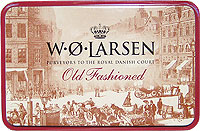 |
 |
Erik: Orlik is an old Danish brand. It was the number one selling premium pipe tobacco in Denmark for many, many years. Orlik is a very nice Virginia flake, and it’s, personally, what I like to smoke. We’ve seen its sales pick up recently too. But it’s still what we consider a niche product. [Editor’s Note: During my trip to Denmark in July 2010, nearly every Danish pipe smoker that I encountered was smoking Orlik Golden Slices. I tried it for the first time in Denmark and loved it]
W.Ø. Larsen is more aromatic, milder, but still with some good character. We have that in three different tins.
Kevin: I’ve smoked the W.Ø. Larsen Old-Fashioned and I enjoyed it quite a bit, but wasn’t sure if it was an aromatic or if it was just a sweet blend of non-aromatic tobacco.
Erik: It is a light aromatic.
In the Stanwell range we have two blends; Melange, which is also a mild aromatic tobacco, and Vanilla.
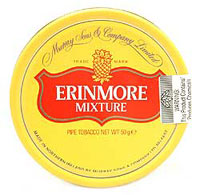 |
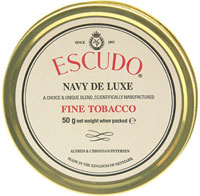 |
 |
Erinmore is an old Irish brand that’s been on the US market for many years, and when Orlik bought that brand, we took over the distribution of it.
Escudo is an old disc, not flake, but disc, and it’s almost like a cigar production. You roll up the tobacco almost like rope, and then you let it sit for awhile, and then you cut it into discs. Escudo is an old brand from A&C Peterson, Anderson Poul Petersen. Their company was sold to Orlik as well, years ago, and again, because we’re the importer of Orlik’s products, we took over the distribution of that. That’s also one we consider a niche product, but it’s got a very strong following, and a very high demand.
Balkan Sasieni is a typical English blend, and by that I mean it’s a non-flavored and has Latakia, Virginia and Orientals.
Kevin: Is Balkan Sasieni a replacement for Balkan Sobranie?
Erik: It’s similar, but not the same. It was launched when Balkan Sobranie went out of the market. Balkan Sasieni has developed a pretty good following.
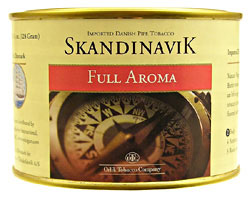 |
|
 |
 |
Skandinavik is an old brand that’s been on the market here since the early 70’s. It is lightly aromatic, and considered to be like an old-fashioned type product, like the old Amphora, which is no longer made.
Sail is an old Dutch-style Cavendish which sold so big on the market here for many years and the same with Troost.
Kevin: Going back to the Peter Stokkebye Tobaccos for a moment, several years ago, I had some of the tins, but I’m not sure if those are still on the market. I haven’t seen them recently.
Erik: No, they’re not. They’re no longer on the market.
Kevin: Stokkebye Tobaccos are strictly in bulk now?
Erik: Correct.
Kevin: In the Stokkebye bulk tobacco, there’s the Gold Series, Silver, and Signature Series. What are the differences in each?
Erik: The Gold Series is a little bit less aromatic type tobacco, and it comes in the two pound bags. The Signature Series reflects most of our bulk tobaccos. And then we have the luxury tobaccos, which is more the flake, twist, flake, and the bulls eye, which is a disc.

Kevin: Does Stokkebye also supply individual tobacconists with tobacco to mix and make their own store blends?
Erik: Yes. We had quite a few come to us and ask us for our recommendations.
Kevin: So there might be some individual store blends that guys love that they really have Stokkebye to thank for… or at least in part.
Erik: Yeah. In part, I think, but then, some stores come to us, some stores go to another manufacturer and mix things together. It’s very individual. Some stores may mix some of ours with somebody else’s.
Kevin: What are some of the best selling Stokkebye bulk tobaccos?
Erik: For years, it’s always been the Peter Stokkebye Nougat (PS-24).
Kevin: I heard that that was the actual tobacco that they smoked in the Lord of the Rings movies. Is that true?
Erik: I don’t know, because that’s the first time I’m hearing it.
Kevin: I heard it from Brian Levine.
Erik: Yes, then I would say that is correct since Brian would have handled that when he worked here.
[Editor’s note: Brian Levine now works for SmokingPipes.com. He told me about this while visiting him there.]

New Stokkebye Villiger 1888 Pipe Tobaccos
Erik: We are launching three new blends under the Villiger 1888 Brand. There are two aromatic blends. One is called Early Day, which is a classic English type blend, and there’s one called Mid Day and there’s one called Late Night.
They are available now from retailers and come in 50 gram tins.
 |
 |
 |
Early Day Tin Description:
Mature golden Virginias blended with Oriental leaf and Latakia from the Balkan region. The rich share of Latakia makes this blend a true English classic with a characteristic smoky room note.
Mid Day Tin Description:
A mixture of double steamed Black Cavendish, blended with Burley, Orient, and light Virgina tobaccos. A delightful aroma and top note vanilla and exotic fruit make this a mild and pleasant smoke in the early afternoon.
Late Night Tin Description:
A classic mixture of bright Virginia from the USA, Africa and Brazil, blended with some fermented Black Cavendish. Genuine Irish whiskey and fresh honey provides this blend an exciting taste and flavor.
Villiger-Stokkebye provides such a large selection of brands, styles, flavors and price-points for the casual and serious pipe smoker, chances are you’ve smoked some or many of them and have become a big fan of their offerings. If by some small chance you have not, chances are you soon will.












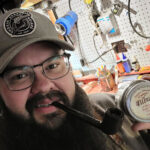

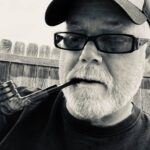



Great Interview I had no Idea that most of my Favorite tobacco in produced by Stokkeby.
Nice piece. I’m curious what I’d have to do to get Erik’s company to produce SWISS DELIGHT again — even in limited runs every year or so. I no sooner found the mixture and it was gone at least from the U.S. market.
I just smoked a bol of the new Villiger 1888 Late Night blend, and it was really good. I’ll do a full review elsewhere, but I can tell you the following:
Tin aroma is lovely, sweet Virginia, orange, and honey. Very dry ine the tin compared to most- I usually smoke Mac Barens. Its obviously a rough cut, un-rubbed flake or cate cut- you can see the bits are pressed together. Smokes cool enough for me, and has a changing palate- I tasted great Virginia flavor, occasionally orange, honey, the Irish Whisky alluded to on the tin, and… other pleasing things. Room note was very pleasant but not too sweet.
This was a Very satisfying smoke- full review to come…
Great article… Interesting to follow the acquisitions that have taken place in the tobacco industry. Bulls eye remains one of my favorites.
They produce and distribute some of my favourite tobaccos as well. I enjoyed reading that interview quite a bit. Interesting perspectives and some great history.
I’m glad Erik recognizes the importance of the “niche” tobaccos like Escudo and Orlik Golden Sliced. While they may not make up the bulk of their sales, they are still vital to the integrity and future success of the Villiger Stokkebye portfolio. These fine blends are known for their high quality, excellent value, and I’m pleased that he recognizes they are on the upswing in popularity. Pipe smokers today are reevaluating old brands and flocking towards the well-made examples; Erik, please preserve these blends for our future smoking pleasure!